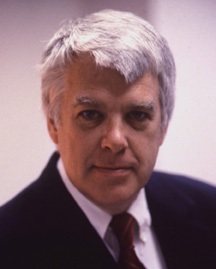Professor Robert R. Birge
The MIT Technology Review article Rewritable Holographic Memory: A genetically engineered microbial protein could mean better data storage. said
“When the protein is in some of these states, its ability to absorb light allows it to form holograms. In the natural environment, each of the states lasts only briefly: the whole cycle takes just 10 to 20 milliseconds. But prior research has shown that shining red light on the protein as it nears the end of its chemical cycle can force it into a useful state — known as the ‘Q state’ — that can last for years.The problem is that the Q state is difficult to produce in the naturally occurring protein. So molecular biologists at UConn, led by Robert Birge of the chemistry department, are genetically manipulating Halobacterium salinarum so that it can produce a protein that enters the Q state more easily.
To serve as part of a holographic system, the protein is suspended in a polymer gel. A green laser beam is split in two, and one beam is encoded with data. The beams are then recombined in the gel, imprinting the proteins with an interference pattern that stores the data. To read the data, the system sends a single, lower-power, red laser beam back through the interference pattern. A blue laser erases the data.”
Robert R. Birge, Ph.D. is Harold S. Schwenk Sr. Distinguished Professor of Biological Chemistry at the University of Connecticut.
Bob’s research is evenly divided into two areas, molecular biophysics and molecular electronics. His biophysics group has the primary goal of studying the structure and function of visual pigments and light-transducing proton pumps. His molecular electronics group investigates the encoding, manipulation, and retrieval of information at a molecular level using bioelectronic and biomimetic methods. Both groups use molecular spectroscopy and quantum theory as the primary tools.
The Nature of Wavelength Regulation in Cone Pigments
His primary interest is the mechanism of wavelength and photochemical regulation in the short wavelength cone pigments. He uses nonlinear laser spectroscopy, vibrational spectroscopy, low temperature photocalorimetry and site directed mutagenesis to isolate the key structural components that characterize these unusual protein binding sites. A recent example of this research can be found in the following article: Photochemistry of the primary event in short-wavelength visual opsins at low temperature.
Molecular Electronics and Protein-based Devices
His research in this area emphasizes biomolecular electronics, the use of biological molecules or biomimetic approaches to make electronic components or systems. He uses the protein bacteriorhodopsin to make a variety of devices that exploit the unique abilities of this protein to convert light into a refractive index or an optical density gradient. Current devices under study include an artificial retina, an optical associative processor, and a three-dimensional memory. He also uses both site-directed mutagenesis and directed evolution to optimize the protein for each application. Protein-based associative processors and volumetric memories.
Molecular Orbital Theory of Large Systems
His theoretical research develops and applies semiempirical procedures aimed at studying protein structure and function using quantum chemical methods. His mndoci method is capable of handling the first and second shells of protein binding sites containing many hundreds of atoms while simultaneously carrying out full single and double configuration interaction on the protein-bound chromophore. This approach requires careful parameterization coupled with transformation procedures that provide a tractable basis set while simultaneously treating the surrounding protein using a full valence SCF basis set. Reparameterizing MNDO for excited state calculations using ab initio effective Hamiltonian theory: Application to the 2,4-pentadien-1-iminium cation; The nature of the chromophore binding site of bacteriorhodopsin: The potential role of Arg-82 as a principal counterion.
Bob earned his B.S. at Yale University in 1968 and his Ph.D. at Wesleyan University in 1972.
Read his LinkedIn profile.
